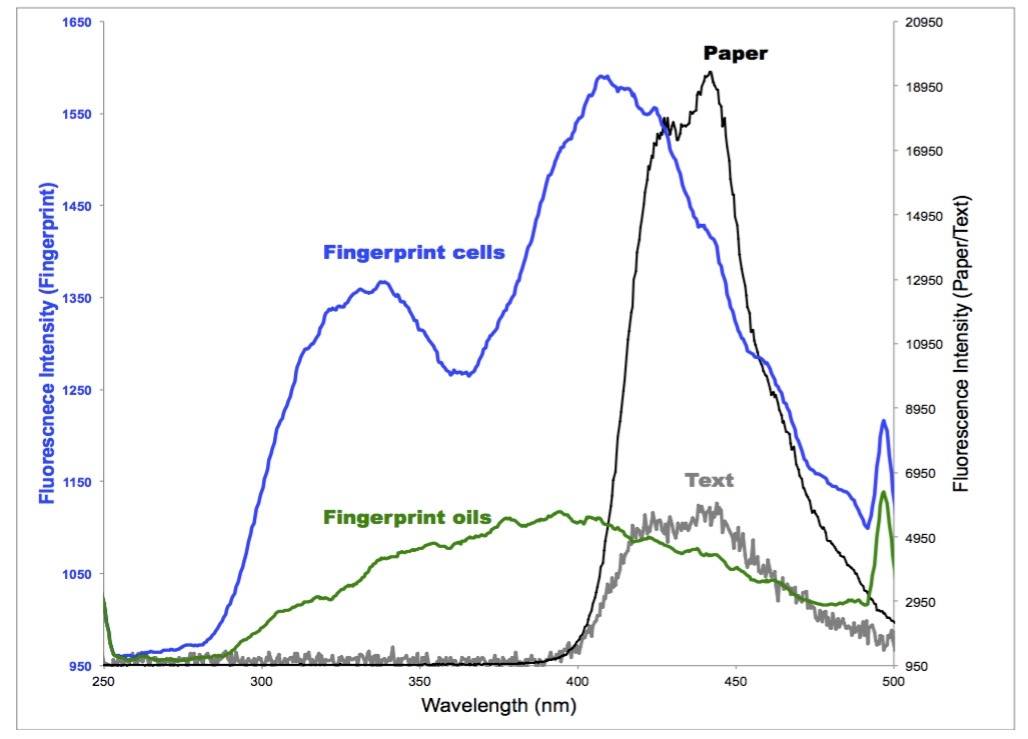Most organic and many inorganic materials absorb strongly in specific wavelength ranges in the deep UV between about 220nm and 300nm. Excitation within these absorption bands results in native fluorescence (autofluorescence) emission. Each compound or composite material, such as a virus or bacterial spore, has a unique excitation-emission fingerprint that can be used to provide information about the material. The sensitivity and specificity with which these materials can be detected and identified depends on the excitation wavelength and the number and location of observation wavelengths.
It is possible to quantitatively differentiate a wide range of biochemical agent targets against a wide range of background materials. By understanding the relationship between spectral resolution and specificity in target identification, simple, fast, algorithms can be developed to identify materials.
Hand-held, battery operated instruments using a deep UV laser and multi-band detection have been developed and deployed on missions to the Antarctic, the Arctic, and the deep ocean with the capability of detecting a single bacterial spore and to differentiate a wide range of organic and biological compounds.
There are several present-day techniques that can identify or classify biological or chemical materials in laboratories. In a laboratory setting, the size and power consumption of the instrument are not of problematic, nor is the requirement for sample handling, preparation, or the use of reagents. When dealing with in-situ field environments, portability of the instrument, power requirements, environmental factors, and the use of consumable reagents affect the ability to migrate typical lab instruments and experiments to the field. To overcome the challenges of in-situ observations, we have focused on non-contact, non-destructive methods to detect biological and chemical materials that may be present on surfaces or in water. We employ laser excitation of endogenous fluorophores intrinsic to the target material being detected. Unlike Laser induced fluorescence (LIF) which uses a chemical/biological tag for the material of interest, Laser induced Native Fluorescence (LINF) is a reagentless method requiring no sample handling or preparation. In addition, this method avoids many of the problems of derivatization or samples with dye tags, and examines the sample in the natural, undisturbed state.
Native Fluorescence (autofluorescence) is a well-known technique used in a variety of areas from differentiating malignant versus benign cancers iii, observing dissolved organic carbon (DOCs) in the ocean, detection of life in sandstones in Antarctica, to detection of weaponized Bacillus anthracis or other harmful materials on surfaces or in water. LINF is an extremely sensitive method to provide preliminary information about the location and potential hazard of a trace contaminant. The sensors we are developing fall into the category of “trigger” since they are very sensitive and provide some level of information about the hazard. When detecting biological or chemical materials used in biochemical warfare, it is important that the technique used as a trigger provide as much information about the material such that false alarm rates are reduced and secondary confirmatory systems are used only when necessary. These sensors a higher level of specificity than has heretofore been possible with other LINF sensors and therefore can reduce the demand on higher level confirmation sensors. Native Fluorescence (autofluorescence) integrates well with confirmation sensors such as resonance Raman-based sensors.

Get In Touch
Keep informed about the latest deep UV developments at Photon Systems by joining our mailing list.
ADDRESS
1512 Industrial Park St. Covina, CA 91722-3417
PHONE
626 967-6431
